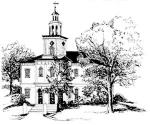 Home
Home Who are we?
Who are we? The Staff
The Staff Our History
Our History Mission
Mission Music/Choir
Music/Choir A Word from
A Word fromThe Pastors
 Sermons
Sermons Christian Growth
Christian Growth Youth Ministries
Youth Ministries Open & Affirming
Open & Affirming News
News Order of Worship
Order of Worship Monthly Calendar
Monthly Calendar Other Links
Other Links
Our History

The First Church in Exeter was gathered in 1638 by the founder of the town of Exeter, the Rev.John Whelewright, a Puritan minister who had been exiled from colonial Massachusetts because of his unorthodox views. A few years later the New Hampshire colony came under the control of Massachusetts, and he was obliged to move again, this time to Maine. When his successor, the Rev. Samuel Dudley, died in 1663, there was a period of struggle to maintain the life of the Church. In 1698 a reorganization assured a continuing existence by the calling of a settled minister, the Rev John Clark. The Covenant adopted by the members at this reorganization is still extant, and an updated version of it is in use today. During the time of the Great Awakening in 1743, a group, of which John Phillips was a leader, broke away from the First Church and founded a new congregation, the Second Parish. John Phillips later founded Phillips Exeter Academy, an independent secondary school. It wasn't until 1920 that the two parishes were rejoined under the name of the Congregational Church in Exeter.
In recent history, the church voted to become a part of the newly formed United Church of Christ in 1961. In 1967, the traditional dual system of Church and Parish gave way to a single body politic with a new constitution and by-laws. The members drafted and adopted a Mission Statement in 1995 to spell out its vision and priorities for the turn of the century. It is here. Most recently, in 1996, the congregation voted to become an Open and Affirming church.
The Church's Meeting House
Beginning in 1638 until late in the 18th century the Town and Parish were one. The maintenance of the Meeting House and the support of the minister were the responsibility of all the townspeople. The building was primarily used for public worship but it also provided secular services and a place for town meetings and the meetings of the legislature when Exeter was the provincial and revolutionary capital of New Hampshire.
The present building, which was built in 1798, (see note below) is the fifth structure to house the Congregational Church. The preceding two smaller meeting houses were located practically at the same site, while the first two were built in the northwestern part of the town near where Salem St. crosses the railroad tracks. An engraved granite stone marks their approximate location.
The front facade of the church is much as it was built by James Folsom from plans drawn up by Ebenezer Clifford, both Exeter citizens. Inside the building there was originally one large room with box pews around the sides and benches in the middle. A high pulpit with a sounding board above was located on the north side opposite the front doors. In 1838 the ground floor was divided into a large and small vestry with a hall between them, and the present stairs were added to give access to the new second floor auditorium, which had an east-west axis with a pulpit and pews as they are now. Pews were owned by families, and could be willed by heirs until all pews were declared free in 1920. In the choir loft at the rear an Estey pipe organ was installed in 1886, and this was replaced with an Aeolian Skinner pipe organ in 1951.
A small churchyard on the east side of the building consists of stones that were moved to that location from another nearby. In the churchyard there is a new Memorial Garden created as a place to inter ashes.
An article which describes our 200th Anniversary celebration is here